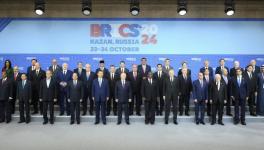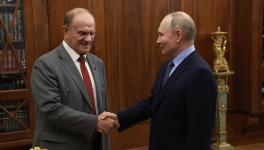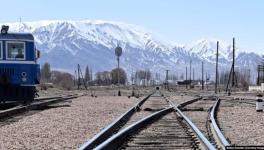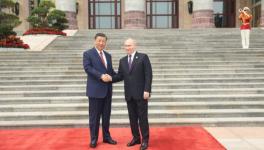Inequality Sharply Higher, Life Harsher in Post-Soviet Russia

Picture courtesy: BBC
The centenary of the October Revolution in Russia has spurred a flurry of commentary. Much of the mainstream media, including “liberal” media outlets, have looked upon the collapse of the Soviet Union as “proof” of the ultimate triumph of capitalism and the failure of socialism. The underlying assumption, of course, is that conditions of living in Russia and other countries which formed part of the erstwhile socialist block became better for the people of those countries. How does this match up to facts?
The Soviet Union was dissolved in December 1991. Mikhail Gorbachev resigned as President of the Soviet Union, and Boris Yeltsin, the President of Russia, embarked on a rapid-fire privatisation of the country's approximately 225,000 state-owned enterprises. He had lifted price controls in October that year, in the expectation that "liberalisation of prices will put everything in its right place".
The effects were immediate, and devastating. Rampant inflation led to millions of people losing their life savings. A third of the population fell below the poverty line. Industrial production contracted by 60 percent in 1990-99, while GDP fell by 54%. This loss was greater than the loss suffered by Russia during World War II, when industrial production fell 24 percent. As Nobel-prize winning economist Joseph Stiglitz notes in his 2002 book Globalization and its Discontents, “What had been envisioned as a short transition recession turned into one of a decade or more. The bottom seemed never in sight… Farm livestock decreased by half, investment in manufacturing came almost to a stop.”
Even as the vast majority of people suffered, well-connected elites used their influence to grab for a song the public assets worth billions that were up for sale. A brief quote from Naomi Klein’s 2007 book The Shock Doctrine is enough to provide a glimpse into the scale of the loot:
“Forty percent of an oil company comparable in size to France's Total was sold for $88 million (Total's sales in 2006 were $193 billion). Norilsk Nickel, which produced a fifth of the world's nickel, was sold for $170 million — even though its profits alone soon reached $1.5 billion annually. The massive oil company Yukos, which controls more oil than Kuwait, was sold for $309 million; it now earns more than $3 billion in revenue a year. Fifty-one percent of the oil giant Sidanko went for $130 million; just two years later that stake would be valued on the international market at $2.8 billion. A huge weapons factory sold for $3 million, the price of a vacation home in Aspen.”
The oligarchs who made immense fortunes out of the misery of the Russian people then proceeded to get their money out of the country. As Stiglitz notes, keeping the money in Russia would have meant investing it in a country in deep depression, and there was the risk that the next government would seize the assets pointing out the illegitimacy of the privatisation process.
The human cost of the collapse was massive. Mortality rates, for instance, rose sharply - adult female mortality rates rose from 116 per 1000 in 1990 to 178 in 1994, while adult male mortality rates increased from 316 to 486 over the same period. Mortality rates in the country started declining significantly only after 2005, but even in 2014, mortality rates were higher than in 1990. (The big gap between the male and female mortality rates is mostly attributed to the higher consumption of vodka among men.) Even infant mortality rates went up for a few years before they started to return to earlier levels and lower.
The stark rise in income inequality in post-Soviet Russia compared to the historically low levels of inequality that prevailed in the Soviet Union may be one of the starkest expressions of the change that has occurred. The publication of new estimates of the income-shares of various classes of people in Russia by Thomas Piketty and team, which was reproduced in a July 2017 paper by Filip Novokmet, Thomas Piketty and Gabriel Zucman, threw valuable light on the contrast between the conditions in the Soviet Union compared to the situation before it came into existence and after its disintegration.
Income inequality in Tsarist Russia was very high. The top 10% of earners in the country accounted for 47% of the total national income in 1905. The income-share of the richest 1% was a whopping 18% that year.
The period following the Bolshevik Revolution saw a steep reduction in income inequality, with the income share of the top 10% declining to 22% in 1928, and that of the top 1% falling to 4%. These shares remained at more or less similar levels till the collapse of the Soviet Union.
The rise in income inequality in the period following the collapse of the Soviet Union has been drastic. The income-share of the richest 10% rose from 25% in 1991 to 52% in 2008. The share of the top 1% rose from 8% in 1991 to touch a peak of 27% in 2007. The income-shares of the richest sections came down somewhat in the subsequent years - the top 10%'s share touched 46% in 2012 and has remained at similar levels since then. The top 1%'s share decreased to 21% in 2009 and has hovered around the 20-21% mark ever since.
Source for data: WID.world
The rise in the fortunes of the rich is mirrored by the decline in the fortunes of the people belonging to the middle-income and lower-income categories.
The income-share of the 'middle 40%' in Tsarist Russia was 36% in 1905. This increased to 48% in 1928, and remained more or less at the same level till the end of the Soviet Union. Their share declined following the spate of privatisations and subsidy cuts in post-Soviet Russia, to touch 37% in 2001. The middle classes' income-share has remained around that level since then.
The share of the bottom 50% was 17% in 1905 and increased steeply following the October Revolution, to touch 30% in 1928. As in the case of the other categories, the share of the bottom 50% remained more or less stable around these levels till 1991. Their share decreased sharply as poverty and unemployment returned to Russia with a vengeance following the restoration of capitalism. The bottom 50% accounted for about 17% of the total national income in 2015.
The policies that led up to all these – starting with the bonanza handed over by Boris Yeltsin to the oligarchs – did not go without opposition. The Russian Parliament, for instance, opposed these policies, and Yeltsin responded by abolishing the constitution and dissolving the parliament. The Parliament, in turn, voted 636-2 to impeach Yeltsin, who went on to crush the resistance to his policies with a brutal military assault which left about 500 people dead and almost a thousand wounded.
Renowned Indian historian Irfan Habib captured the brutality of one of the episodes which formed part of this ruthless, but oft-forgotten, repression in these memorable words:
“Boris Yeltsin, the darling of Washington, the President of Russia, turned dictator, found in the Russian Supreme Soviet (Parliament) an obstacle to his handing over state-owned industries, created under socialism, to capitalist mafias. He thereupon dissolved the Supreme Soviet in September 1993; and when the latter refused to accept his illegal decree, he immediately brought in the army… Yeltsin had the artillery trained on the Soviet building. When the shelling was over, 144 Russians lay dead. Since it was a murderous act for the noble cause of Russia's New Rich, no one's conscience was troubled, and no flowers are laid in memory, nor anniversaries observed, of the Moscow dead in New York, London or Paris."
Get the latest reports & analysis with people's perspective on Protests, movements & deep analytical videos, discussions of the current affairs in your Telegram app. Subscribe to NewsClick's Telegram channel & get Real-Time updates on stories, as they get published on our website.
























